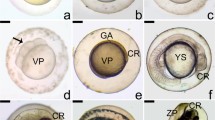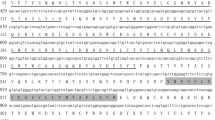Summary
The present report firstly describes a pilot study in which, during early development of embryos of the common carp, Cyprinus carpio, the cellular adhesion to fibronectin (FN) was blocked by administration of GRGDS peptide (which binds to the FN-receptor). As this treatment resulted in developmental aberrations, suggesting a functional role for FN, the major part of the work was focussed on the distribution of reactivity of anti-FN antibodies during epiboly and gastrulation. GRGDS treatment had a concentration dependent effect on development. Incubation of embryos in 1.5 mg/ml from the 32-cell stage onwards caused a retardation of epiboly, which did not proceed beyond 60%. The embryos did not show involution, as was confirmed by histological study. These preliminary results suggest that FN is involved in both epiboly and gastrulation of carp embryos. During cleavage, no specific extracellular binding of anti-FN antiserum could be observed. However, binding to a number of cell membranes took place from early epiboly onwards. After the onset of gastrulation, we observed a gradually increasing number of the deepest epiblast cells, showing immunostaining on part of their surface, facing the yolk syncytial layer (YSL) or the involuted cells. During early epiboly, anti-FN binding was restricted to areas in front of the migratory hypoblast cells. Later on, binding was found at the border of hypoblast and epiblast cells. At 100% epiboly, some contact areas of epiblast and hypoblast showed a discontinuous lining of reactivity, whilst other areas appeared devoid of anti-FN binding sites. The results indicate that FN is involved in the migration and guidance of hypoblast cells during gastrulation in carp.
Similar content being viewed by others
References
Aumailley M, Gerl M, Sonnenberg A, Deutzmann R, Timpl R (1990) Identification of the arg-gly-asp sequence in laminin A chain as a latent cell binding site being exposed in fragment P1. FEBS Lett 262:82–86
Boucaut JC, Darribere T (1983) Presence of fibronectin during early embryogenesis in the amphibian Pleurodeles walthi. Cell Differ 12:77–83
Boucaut JC, Darribere T, Poole TJ, Aoyama H, Yamada KM, Thiery JP (1984) Biologically active synthetic peptides as probes of embryonic development: a competitive peptide inhibitor of fibronectin function inhibits gastrulation in amphibian embryos and neural crest cell migration in avian embryos. J Cell Biol 99:1822–1830
Boucaut JC, Darribere T, Shi DL, Boulekbache H, Yamada KM, Thiery JP (1985) Evidence for the role of fibronectin in amphibian gastrulation. J Embryol Exp Morphol 89 (Suppl):211–227
Boucaut JC, Johnson KE, Darribere T, Shi DL, Rion JF, Boulekbache H, Delarue M (1990) Fibronectin-rich extracellular material controls cell migration during amphibian gastrulation. Int J Dev Biol 34:139–147
Boulekbache H, Darribere T, Joly C, Boucaut JC, Thiery JP (1984) Immunolocalization of fibronectin in fish embryo; involvement in gastrulation and epiboly. J Embryol Exp Morphol 82 Suppl 25a
Brown AJ, Sanders EJ (1991) Interactions between mesoderm cells and the extracellular matrix following gastrulation in the chick embryo. J Cell Sci 99:431–441
Buck CA, Horwitz AF (1987) Cell surface receptors for extracellular matrix molecules. Ann Rev Cell Biol 3:179–205
Critchley DR, England MA, Wakeley J, Hynes RO (1979) Distribution of fibronectin in the ectoderm of gastrulating chick embryos. Nature 280:498–500
Darribère T, Boucher D, Lacroix JC, Boucaut JC (1984) Fibronectin synthesis during oogenesis and early development of the amphibian Pleurodeles waltl. Cell Differ 14:171–177
Darribère T, Rion JF, Shi DL, Delarue M, Boucaut JC (1986) Synthesis and distribution of laminin-related polypeptides in early amphibian embryos. Cell Tissue Res 246:45–51
Darribère T, Yamada KM, Johnson KE, Boucaut JC (1988) The 140 kD fibronectin receptor complex is required for mesodermal cell adhesion during gastrulation in the amphibian Pleurodeles wahltl. Dev Biol 126:182–194
Duband JP, Thiery JP (1982) Appearance of fibronectin during chick embryo gastrulation. Dev Biol 94:337–350
Gevers P, Timmermans LPM (1991) Dye-coupling and formation and fate of the hypoblast in the teleost fish embryo, Barbus conchonius. Development 112:431–438
Grant DS, Tashiro KI, Segui-Real B, Yamada Y, Martin GR, Kleinman HK (1989) Two different laminin domains mediate the differentiation on human endothelial cells into capillary-like structures in vitro. Cell 58:933–943
Harrisson F, Van Hoof J, Foidart JM (1984a) Demonstration of interaction between glycosaminoglycans and fibronectin in the basement membrane of the living chick embryo. Roux's Arch Dev Biol 193:418–421
Harrisson F, Vanroelen Ch, Foidart JM, Vakaet L (1984b) Expression of different regional patterns of fibronectin immunoreactivity during mesoblast formation in the chick blastoderm. Dev Biol 101:373–381
Harrisson F, Vanroelen Ch, Vakaet L (1985) Fibronectin and its relation to the basal lamina and to the cell surface in the chicken blastoderm. Cell Tissue Res 241:391–397
Harrisson F, Andries L, Vakaet L (1988) The chicken blastoderm: current views on cell biological events guiding intercellular communication. Cell Differ 22:83–106
Horwitz A, Duggan K, Greggs R, Decker C, Buck C (1985) The cell-substrate attachement (CSAT) antigen has properties of a receptor for laminin and fibronectin. J Cell Biol 101:2134–2144
Hynes RO (1987) Integrins: a family of cell surface receptors. Cell 48:549–554
Kimmel CB, Warga RM (1987) Indeterminate cell lineage of the zebrafish embryo. Dev Biol 124:269–280
Kimmel CB (1989) Genetics and early development of zebrafish. Trends Genet 5:283–288
Laemmli UK (1970) Cleavage of structural proteins during the assembly of the head of the bacteriophage T4. Nature 27:580–585
Lash JW, Gosfield E, Ostrawsky D, Bellairs R (1990) Migration of chick blastoderm under the vitelline membrane: the role of fibronectin. Dev Biol 139:407–416
Lee G, Hynes RO, Kirschner M (1984) Temporal and spatial regulation of fibronectin in early Xenopus development. Cell 36:729–740
Nakatsuji N, Hashimoto K, Hayashi M (1985) Laminin fibrils in newt gastrulae visualized by the immunofluorescent staining. Dev Growth Differ 27:639–643
Raddatz E, Monnet-Tschudi F, Verdan C, Kucera P (1991) Fibronectin distribution in the chick embryo during formation of the blastula. Anat Embryol 183:57–65
Ruoslahti E, Pierschbacher MD (1986) Arg-gly-asp: a versatile recognition signal. Cell 44:517–518
Sanders EJ (1980) The effect of fibronectin and substratum attached material on the spreading of chick embryo mesoderm cells in vitro. J Cell Sci 44:225–242
Sanders EJ (1982) Ultrastructural immunocytochemical localization of fibronectin in the early chick embryo. J Embryol Exp Morphol 71:155–170
Sanders EJ, Prasad S (1991) Possible roles for TGF-β in the gastrulating chick embryo. J Cell Sci 99:617–626
Skalli O, Goldman RD (1991) Recent insights into the assembly, dynamics and function of intermediate filament networks. Cell Motil Cytoskeleton 19:67–79
Slack JMW (1990) Growth factors as inducing agents in early Xenopus development. J Cell Sci 13:119–130
Smith JC (1989) Mesoderm induction and mesoderm inducing factors in early amphibian development. Development 105:665–677
Smith JC, Symes K, Hynes RO, DeSimone D (1990) Mesoderm induction and the control of gastrulation in Xenopus laevis: the role of fibronectin and integrins. Development 108:229–238
Tamkun JW, DeSimone DW, Fonda D, Patel RS, Buck CA, Horwitz AF, Hynes RO (1986) Structure of integrin, a glycoprotein involved in the transmembrane linkage between fibronectin and actin. Cell 46:271–282
Toyoizumi R, Takeuchi S (1992) Morphometry of cellular protrusions of mesodermal cells and fibrous extracellular matrix in the primitive streak stage embryo. Roux's Arch Dev Biol 201:36–44
Toyoizumi R, Shiokawa K, Takeuchi S (1991) The behavior and cytoskeletal system of chick gastrula mesodermal cells on substrata coated with lines of fibronectin. J Exp Zool 260:345–353
Trinkaus JP, Trinkaus M, Fink RD (1992) On the convergent cell movements of gastrulation in Fundulus. J Exp Zool 261:40–61
Warga RM, Kimmel CB (1990) Cell movements during epiboly and gastrulation in zebrafish. Development 108:569–580
Winklbauer R (1990) Mesodermal cell migration during Xenopus gastrulation. Dev Biol 142:155–168
Winklbauer R, Nagel M (1991) Directional mesodermal cell migration in the Xenopus gastrula. Dev Biol 148:573–589
Wood A, Timmermans LPM (1988) Teleost epiboly: a reassessment of deep cell movement in the germ ring. Development 102:575–585
Yamada KM, Kennedy DW (1984) Dualistic nature of adhesive protein function: fibronectin and its biologically active peptide fragments can autoinhibit fibronectin function. J Cell Biol 99:29–36
Yamada KM, Kennedy DW (1987) Peptide inhibitors of fibronectin, laminin and other adhesion molecules: unique and shared features. J Cell Physiol 130:21–28
Zagris N, Chung AE (1990) Distribution and functional role of laminin during induction of the embryonic axis in the chick embryo. Differentiation 43:81–86
Author information
Authors and Affiliations
Additional information
Correspondence to: P. Gevers
Rights and permissions
About this article
Cite this article
Gevers, P., Coenen, A.J.M., Schipper, H. et al. Involvement of fibronectin during epiboly and gastrulation in embryos of the common carp, Cyprinus carpio . Roux's Arch Dev Biol 202, 152–158 (1993). https://doi.org/10.1007/BF00365305
Received:
Accepted:
Issue Date:
DOI: https://doi.org/10.1007/BF00365305




